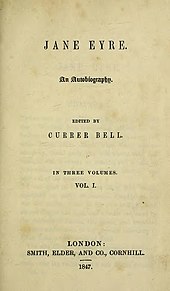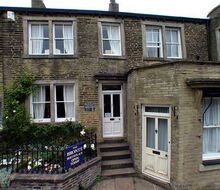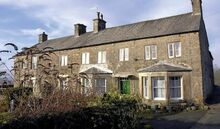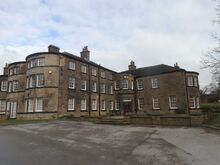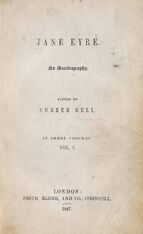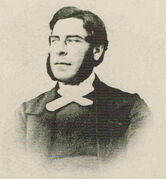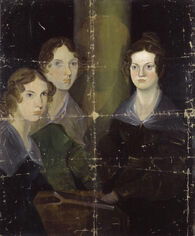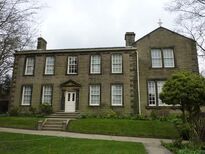- 13.11.2018
Тема по английскому языку: Шарлотта Бронте
Топик по английскому языку: Шарлотта Бронте (Charlotte Bronte). Данный текст может быть использован в качестве презентации, проекта, рассказа, эссе, сочинения или сообщения на тему.
Происхождение
Шарлотта Бронте родилась 21 апреля 1816 года. Она посещала школу Клержи для девочек в Ланкашире в 1824. Однако в следующем году она вернулась домой из-за суровых условий и после смерти двух ее сестер. В 1831 она пошла в школу в Ро Хэд, где позже работала учителем. Однако она заболела, страдала от меланхолии, и ей пришлось оставить эту должность. Шарлотта пыталась работать гувернанткой, но всем ее попыткам мешала застенчивость, ее неосведомленность о детях и стремление быть с сестрами.
Переезд в Брюссель
В 1842 Шарлотта поехала со своей сестрой Эмили в Брюссель, чтобы изучать французский, немецкий и менеджмент. Она провела там менее двух лет, а когда вернулась домой, страдала от сильной ипохондрии.
Первые работы
В 1846 три сестры – Шарлотта, Эмили и Анна опубликовали книгу Поэм, и хотя уровень продаж был очень низким, отзывы были хорошими. Роман Шарлотты Профессор был совсем неудачным.
Роман Джейн Эйр
В августе 1846 Шарлотта начала работать над романом Джейн Эйр, который был опубликован только в октябре 1847 и незамедлительно стал популярным. Шарлотта посвятила эту книгу Уильяму Мэйкпису Теккерею, который описал ее как «шедевр великого гения». Героиня Джейн Эйр – безденежная сирота, которая становится учительницей, получает должность гувернантки, наследует деньги от отца и затем выходит замуж. Шарлотта использовала свой личный опыт обучения в евангельской школе и работы гувернанткой.
Смерть близких
В 1848 и 1849 годах брат Шарлотты и ее сестра Анна умерли. Горе Шарлотты отражено в последней трети романа Ширли, над которым она работала в то время. Главная героиня книги – независимая, смелая и откровенная женщина.
Замужество и кончина
В 1854 году Шарлотта вышла замуж за викария отца по имени Артур Бел Николс. Она умерла во время беременности 31 марта 1855.
Скачать Топик по английскому языку: Шарлотта Бронте
Charlotte Bronte
Background
Charlotte Brontë was born 21 April 1816. She attended Clergy Daughter’s School in Lancashire in 1824. However, she returned home next year because of the harsh conditions and the death of her two sisters. In 1831 she went to school at Roe Head, where she later worked as a teacher. However, she fell ill, suffered from melancholia, and gave up this post. Charlotte tried to work as a governess but her attempts were hindered by her shyness, her ignorance of normal children, and her yearning to be with her sisters.
Brussels
In 1842, Charlotte travelled to Brussels with Emily to learn French, German, and management. She spent less than two years there and when she came back home she suffered from severe hypochondria.
First works
In 1846 the three sisters – Charlotte, Emily and Ann published a book of Poems, and though sales were very slow, the reviews were quite good. Charlotte’s novel The Professor wasn’t successful at all.
Jane Eyre
In August of 1846 Charlotte began to work on Jane Eyre, which was published only in October, 1847 and immediately became popular. Charlotte dedicated the book to William Makepeace Thackeray, who described it as «the masterwork of a great genius». The heroine of Jane Eyre is a penniless orphan who becomes a teacher, obtains a post as a governess, inherits money from an uncle, and then marries. In this book Charlotte used her experiences at the Evangelical school and as governess.
Close ones dying
In the years of 1848 and 1849 Charlotte’s brother and her sister Ann died. Charlotte’s grief was reflected in the last third of the novel Shirley, which she had been working on at that time. The main character of the book is an independent, brave and outspoken woman.
Marriage and death
In 1854 Charlotte Bronte married her father’s curate, Arthur Bell Nicholls. She died during her pregnancy on March 31, 1855.
Текст Charlotte Brontfi (1816 – 1855) с переводом.
Charlotte Brontfi (1816 – 1855)
Шарлотта Бронте (1816 – 1855)
| Charlotte Brontfi was born in Yorkshire, England. After her mother’s death in 1821, Charlotte was sent away to school by her aunt. The poor conditions there affected her health badly. After finishing school, Charlotte first worked as a teacher and then as a governess for various families in Yorkshire. She wrote four novels, one of which, The Professor (1857), was published two years after her death. She also wrote Shirley (1849), Villette (1853) and her most popular novel, Jane Eyre (1847). | Шарлотта Бронте родилась в графстве Йоркшир в Англии. После смерти матери в 1821 году Шарлотту была отправлена тетей в школу. Плохие условия там сильно повлияли на ее здоровье. После окончания школы Шарлотта сначала работала учительницей и потом гувернанткой в различных семьях в Йоркшире. Она написала четыре романа, один из которых – “Профессор” (1857) – был опубликован через два года после ее смерти. Также она написала “Ширли” (1849), Городок (1853) и свой самый популярный роман Джейн Эйр (1847). | |
| Jane Eyre tells the story of an orphaned girl who is brought up by her unkind aunt and cousins John, Eliza and Georgiana, until she is eventually sent away to an awful school. The book then follows Jane’s difficult life until she finally finds love and happiness. Jane Eyre has been made into several successful films and TV series and is one of the most well-known and best loved books in English literature. | Роман “Джейн Эйр” повествует об осиротевшей девочке, которая воспитывается своей недобной тетей и свои двоюродным братом Джоном и двоюродными сестрами Элизой и Джорджианой, пока ее в конце концов не отправляют в ужасную школу. Книга рассказывает о трудной жизни Джейн, пока она, наконец, не находит любовь и счастье. По роману “Джейн Эйр” несколько раз были успешно сняты фильмы и сериалы, и этот роман является одним из самых известных и любимых книг в английской литературе. |
|
Charlotte Brontë |
|
|---|---|
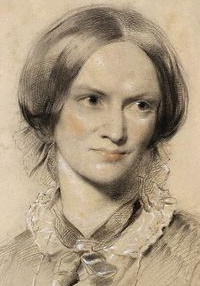
Portrait by George Richmond |
|
| Born | 21 April 1816 Thornton, Yorkshire, England |
| Died | 31 March 1855 (aged 38) Haworth, Yorkshire, England |
| Resting place | St Michael and All Angels’ Church Haworth, England |
| Pen name |
|
| Occupation | Novelist, poet, governess |
| Genre | Fiction, poetry |
| Notable works |
|
| Spouse |
Arthur Bell Nicholls (m. 1854) |
| Parents |
|
| Relatives | Brontë family |
| Signature | |
Charlotte Brontë (, commonly ;[1] 21 April 1816 – 31 March 1855) was an English novelist and poet, the eldest of the three Brontë sisters who survived into adulthood and whose novels became classics of English literature.
She enlisted in school at Roe Head in January 1831, aged 14 years. She left the year after to teach her sisters, Emily and Anne, at home, returning in 1835 as a governess. In 1839, she undertook the role of governess for the Sidgwick family, but left after a few months to return to Haworth, where the sisters opened a school but failed to attract pupils. Instead, they turned to writing and they each first published in 1846 under the pseudonyms of Currer, Ellis, and Acton Bell. Although her first novel, The Professor, was rejected by publishers, her second novel, Jane Eyre, was published in 1847. The sisters admitted to their Bell pseudonyms in 1848, and by the following year were celebrated in London literary circles.
Charlotte Brontë was the last to die of all her siblings. She became pregnant shortly after her marriage in June 1854 but died on 31 March 1855, almost certainly from hyperemesis gravidarum, a complication of pregnancy which causes excessive nausea and vomiting.[a]
Early years and education[edit]
Charlotte Brontë was born on 21 April 1816 in Market Street, Thornton, west of Bradford in the West Riding of Yorkshire, the third of the six children of Maria (née Branwell) and Patrick Brontë (formerly surnamed Brunty), an Irish Anglican clergyman. In 1820 her family moved a few miles to the village of Haworth, where her father had been appointed perpetual curate of St Michael and All Angels Church. Maria died of cancer on 15 September 1821, leaving five daughters, Maria, Elizabeth, Charlotte, Emily and Anne, and a son, Branwell, to be taken care of by her sister, Elizabeth Branwell.
In August 1824, Patrick sent Charlotte, Emily, Maria, and Elizabeth to the Clergy Daughters’ School at Cowan Bridge in Lancashire. Charlotte maintained that the school’s poor conditions permanently affected her health and physical development, and hastened the deaths of Maria (born 1814) and Elizabeth (born 1815), who both died of tuberculosis in June 1825. After the deaths of his older daughters, Patrick removed Charlotte and Emily from the school.[2] Charlotte used the school as the basis for Lowood School in Jane Eyre, which is similarly affected by tuberculosis that is exacerbated by the poor conditions.
At home in Haworth Parsonage, Brontë acted as «the motherly friend and guardian of her younger sisters».[3] Brontë wrote her first known poem at the age of 13 in 1829, and was to go on to write more than 200 poems in the course of her life.[4] Many of her poems were «published» in their homemade magazine Branwell’s Blackwood’s Magazine, and concerned the fictional world of Glass Town.[4] She and her surviving siblings – Branwell, Emily and Anne – created this shared world, and began chronicling the lives and struggles of the inhabitants of their imaginary kingdom in 1827.[5][6] Charlotte, in private letters, called Glass Town «her ‘world below’, a private escape where she could act out her desires and multiple identities».[7] Charlotte’s «predilection for romantic settings, passionate relationships, and high society is at odds with Branwell’s obsession with battles and politics and her young sisters’ homely North Country realism, none the less at this stage there is still a sense of the writings as a family enterprise».[8]
However, from 1831 onwards, Emily and Anne ‘seceded’ from the Glass Town Confederacy to create a ‘spin-off’ called Gondal, which included many of their poems.[9][10] After 1831, Charlotte and Branwell concentrated on an evolution of the Glass Town Confederacy called Angria.[5][11] Christine Alexander, a Brontë juvenilia historian,[12] wrote «both Charlotte and Branwell ensured the consistency of their imaginary world. When Branwell exuberantly kills off important characters in his manuscripts, Charlotte comes to the rescue and, in effect, resurrects them for the next stories […]; and when Branwell becomes bored with his inventions, such as the Glass Town magazine he edits, Charlotte takes over his initiative and keeps the publication going for several more years».[13]: 6–7 The sagas the siblings created were episodic and elaborate, and they exist in incomplete manuscripts, some of which have been published as juvenilia. They provided them with an obsessive interest during childhood and early adolescence, which prepared them for literary vocations in adulthood.[5]
Between 1831 and 1832, Brontë continued her education at Roe Head in Mirfield, where she met her lifelong friends and correspondents Ellen Nussey and Mary Taylor.[2] In 1833 she wrote a novella, The Green Dwarf, using the name Wellesley. Around about 1833, her stories shifted from tales of the supernatural to more realistic stories.[14] She returned to Roe Head as a teacher from 1835 to 1838. Unhappy and lonely as a teacher at Roe Head, Brontë took out her sorrows in poetry, writing a series of melancholic poems.[15] In «We wove a Web in Childhood» written in December 1835, Brontë drew a sharp contrast between her miserable life as a teacher and the vivid imaginary worlds she and her siblings had created.[15] In another poem «Morning was its freshness still» written at the same time, Brontë wrote «Tis bitter sometimes to recall/Illusions once deemed fair».[15] Many of her poems concerned the imaginary world of Angria, often concerning Byronic heroes, and in December 1836 she wrote to the Poet Laureate Robert Southey asking him for encouragement of her career as a poet. Southey replied, famously, that «Literature cannot be the business of a woman’s life, and it ought not to be. The more she is engaged in her proper duties, the less leisure will she have for it even as an accomplishment and a recreation.» This advice she respected but did not heed.
In 1839, she took up the first of many positions as governess to families in Yorkshire, a career she pursued until 1841. In particular, from May to July 1839 she was employed by the Sidgwick family at their summer residence, Stone Gappe, in Lothersdale, where one of her charges was John Benson Sidgwick (1835–1927), an unruly child who on one occasion threw the Bible at Charlotte, an incident that may have been the inspiration for a part of the opening chapter of Jane Eyre in which John Reed throws a book at the young Jane.[16] Brontë did not enjoy her work as a governess, noting her employers treated her almost as a slave, constantly humiliating her.[17]
Brontë was of slight build and was less than five feet tall.[18]
Brussels and Haworth[edit]
In 1842 Charlotte and Emily travelled to Brussels to enrol at the boarding school run by Constantin Héger (1809–1896) and his wife Claire Zoé Parent Héger (1804–1887). During her time in Brussels, Brontë, who favoured the Protestant ideal of an individual in direct contact with God, objected to the stern Catholicism of Madame Héger, which she considered a tyrannical religion that enforced conformity and submission to the Pope.[19] In return for board and tuition Charlotte taught English and Emily taught music. Their time at the school was cut short when their aunt Elizabeth Branwell, who had joined the family in Haworth to look after the children after their mother’s death, died of internal obstruction in October 1842. Charlotte returned alone to Brussels in January 1843 to take up a teaching post at the school. Her second stay was not happy: she was homesick and deeply attached to Constantin Héger. She returned to Haworth in January 1844 and used the time spent in Brussels as the inspiration for some of the events in The Professor and Villette.
After returning to Haworth, Charlotte and her sisters made headway with opening their own boarding school in the family home. It was advertised as «The Misses Brontë’s Establishment for the Board and Education of a limited number of Young Ladies» and inquiries were made to prospective pupils and sources of funding. But none were attracted and in October 1844, the project was abandoned.[20]
First publication[edit]
In May 1846 Charlotte, Emily, and Anne self-financed the publication of a joint collection of poems under their assumed names Currer, Ellis and Acton Bell. The pseudonyms veiled the sisters’ sex while preserving their initials; thus Charlotte was Currer Bell. «Bell» was the middle name of Haworth’s curate, Arthur Bell Nicholls whom Charlotte later married, and «Currer» was the surname of Frances Mary Richardson Currer who had funded their school (and maybe their father).[21] Of the decision to use noms de plume, Charlotte wrote:
Averse to personal publicity, we veiled our own names under those of Currer, Ellis and Acton Bell; the ambiguous choice being dictated by a sort of conscientious scruple at assuming Christian names positively masculine, while we did not like to declare ourselves women, because – without at that time suspecting that our mode of writing and thinking was not what is called «feminine» – we had a vague impression that authoresses are liable to be looked on with prejudice; we had noticed how critics sometimes use for their chastisement the weapon of personality, and for their reward, a flattery, which is not true praise.[22]
Although only two copies of the collection of poems were sold, the sisters continued writing for publication and began their first novels, continuing to use their noms de plume when sending manuscripts to potential publishers.
The Professor and Jane Eyre[edit]
Brontë’s first manuscript, ‘The Professor’, did not secure a publisher, although she was heartened by an encouraging response from Smith, Elder & Co. of Cornhill, who expressed an interest in any longer works Currer Bell might wish to send.[23] Brontë responded by finishing and sending a second manuscript in August 1847. Six weeks later, Jane Eyre was published. It tells the story of a plain governess, Jane, who, after difficulties in her early life, falls in love with her employer, Mr Rochester. They marry, but only after Rochester’s insane first wife, of whom Jane initially has no knowledge, dies in a dramatic house fire. The book’s style was innovative, combining Romanticism, naturalism with gothic melodrama, and broke new ground in being written from an intensely evoked first-person female perspective.[24] Brontë believed art was most convincing when based on personal experience; in Jane Eyre she transformed the experience into a novel with universal appeal.[25]
Jane Eyre had immediate commercial success and initially received favourable reviews. G. H. Lewes wrote that it was «an utterance from the depths of a struggling, suffering, much-enduring spirit», and declared that it consisted of «suspiria de profundis!» (sighs from the depths).[25] Speculation about the identity and gender of the mysterious Currer Bell heightened with the publication of Wuthering Heights by Ellis Bell (Emily) and Agnes Grey by Acton Bell (Anne).[26] Accompanying the speculation was a change in the critical reaction to Brontë’s work, as accusations were made that the writing was «coarse»,[27] a judgement more readily made once it was suspected that Currer Bell was a woman.[28] However, sales of Jane Eyre continued to be strong and may even have increased as a result of the novel developing a reputation as an «improper» book.[29] A talented amateur artist, Brontë personally did the drawings for the second edition of Jane Eyre and in the summer of 1834 two of her paintings were shown at an exhibition by the Royal Northern Society for the Encouragement of the Fine Arts in Leeds.[19]
Shirley and bereavements[edit]
In 1848 Brontë began work on the manuscript of her second novel, Shirley. It was only partially completed when the Brontë family suffered the deaths of three of its members within eight months. In September 1848 Branwell died of chronic bronchitis and marasmus, exacerbated by heavy drinking, although Brontë believed that his death was due to tuberculosis. Branwell may have had a laudanum addiction. Emily became seriously ill shortly after his funeral and died of pulmonary tuberculosis in December 1848. Anne died of the same disease in May 1849. Brontë was unable to write at this time.
After Anne’s death Brontë resumed writing as a way of dealing with her grief,[30] and Shirley, which deals with themes of industrial unrest and the role of women in society, was published in October 1849. Unlike Jane Eyre, which is written in the first person, Shirley is written in the third person and lacks the emotional immediacy of her first novel,[31] and reviewers found it less shocking. Brontë, as her late sister’s heir, suppressed the republication of Anne’s second novel, The Tenant of Wildfell Hall, an action which had a deleterious effect on Anne’s popularity as a novelist and has remained controversial among the sisters’ biographers ever since.[32]
In society[edit]
In view of the success of her novels, particularly Jane Eyre, Brontë was persuaded by her publisher to make occasional visits to London, where she revealed her true identity and began to move in more exalted social circles, becoming friends with Harriet Martineau and Elizabeth Gaskell, and acquainted with William Makepeace Thackeray and G.H. Lewes. She never left Haworth for more than a few weeks at a time, as she did not want to leave her ageing father. Thackeray’s daughter, writer Anne Isabella Thackeray Ritchie, recalled a visit to her father by Brontë:
…two gentlemen come in, leading a tiny, delicate, serious, little lady, with fair straight hair and steady eyes. She may be a little over thirty; she is dressed in a little barège dress with a pattern of faint green moss. She enters in mittens, in silence, in seriousness; our hearts are beating with wild excitement. This then is the authoress, the unknown power whose books have set all London talking, reading, speculating; some people even say our father wrote the books – the wonderful books. …The moment is so breathless that dinner comes as a relief to the solemnity of the occasion, and we all smile as my father stoops to offer his arm; for, genius though she may be, Miss Brontë can barely reach his elbow. My own personal impressions are that she is somewhat grave and stern, specially to forward little girls who wish to chatter. …Everyone waited for the brilliant conversation which never began at all. Miss Brontë retired to the sofa in the study, and murmured a low word now and then to our kind governess… the conversation grew dimmer and more dim, the ladies sat round still expectant, my father was too much perturbed by the gloom and the silence to be able to cope with it at all… after Miss Brontë had left, I was surprised to see my father opening the front door with his hat on. He put his fingers to his lips, walked out into the darkness, and shut the door quietly behind him… long afterwards… Mrs Procter asked me if I knew what had happened. …It was one of the dullest evenings [Mrs Procter] had ever spent in her life… the ladies who had all come expecting so much delightful conversation, and the gloom and the constraint, and how finally, overwhelmed by the situation, my father had quietly left the room, left the house, and gone off to his club.[33]
Brontë’s friendship with Elizabeth Gaskell, while not particularly close, was significant in that Gaskell wrote the first biography of Brontë after her death in 1855.
Villette[edit]
Brontë’s third novel, the last published in her lifetime, was Villette, which appeared in 1853. Its main themes include isolation, how such a condition can be borne,[34] and the internal conflict brought about by social repression of individual desire.[35] Its main character, Lucy Snowe, travels abroad to teach in a boarding school in the fictional town of Villette, where she encounters a culture and religion different from her own and falls in love with a man (Paul Emanuel) whom she cannot marry. Her experiences result in a breakdown but eventually, she achieves independence and fulfilment through running her own school. A substantial amount of the novel’s dialogue is in the French language. Villette marked Brontë’s return to writing from a first-person perspective (that of Lucy Snowe), the technique she had used in Jane Eyre. Another similarity to Jane Eyre lies in the use of aspects of her own life as inspiration for fictional events,[35] in particular her reworking of the time she spent at the pensionnat in Brussels. Villette was acknowledged by critics of the day as a potent and sophisticated piece of writing although it was criticised for «coarseness» and for not being suitably «feminine» in its portrayal of Lucy’s desires.[36]
Marriage[edit]
This photo-portrait of Ellen Nussey has long been mistaken for one of her friend Charlotte Brontë. The photo is a copy made circa 1918 by the photographer, Sir Emery Walker, from an original carte de visite photo which was then privately owned.[37][38]
Before the publication of Villette, Brontë received an expected proposal of marriage from Irishman Arthur Bell Nicholls, her father’s curate, who had long been in love with her.[39] She initially refused him and her father objected to the union at least partly because of Nicholls’s poor financial status. Elizabeth Gaskell, who believed that marriage provided «clear and defined duties» that were beneficial for a woman,[40] encouraged Brontë to consider the positive aspects of such a union and tried to use her contacts to engineer an improvement in Nicholls’s finances. According to James Pope-Hennessy in The Flight of Youth, it was the generosity of Richard Monckton Milnes that made the marriage possible. Brontë meanwhile was increasingly attracted to Nicholls and by January 1854 she had accepted his proposal. They gained the approval of her father by April and married in June.[41] Her father Patrick had intended to give Charlotte away, but at the last minute decided he could not, and Charlotte had to make her way to the church without him.[42] The married couple took their honeymoon in Banagher, County Offaly, Ireland.[43] By all accounts, her marriage was a success and Brontë found herself very happy in a way that was new to her.[39]
Death[edit]
Brontë became pregnant soon after her wedding, but her health declined rapidly and, according to Gaskell, she was attacked by «sensations of perpetual nausea and ever-recurring faintness».[44] She died, with her unborn child, on 31 March 1855, three weeks before her 39th birthday. Her death certificate gives the cause of death as phthisis,[45] i.e. consumption (not tuberculosis, which was only one of many diseases included in this now outdated classification), but biographers including Claire Harman and others suggest that she died from dehydration and malnourishment due to vomiting caused by severe morning sickness or hyperemesis gravidarum.[46] Brontë was buried in the family vault in the Church of St Michael and All Angels at Haworth.
The Professor, the first novel Brontë had written, was published posthumously in 1857. The fragment of a new novel she had been writing in her last years has been twice completed by recent authors, the more famous version being Emma Brown: A Novel from the Unfinished Manuscript by Charlotte Brontë by Clare Boylan in 2003. Most of her writings about the imaginary country Angria have also been published since her death. In 2018, The New York Times published a belated obituary for her.[47]
Religion[edit]
The daughter of an Irish Anglican clergyman, Brontë was herself an Anglican. In a letter to her publisher, she claims to «love the Church of England. Her Ministers indeed, I do not regard as infallible personages, I have seen too much of them for that – but to the Establishment, with all her faults – the profane Athanasian Creed excluded – I am sincerely attached.»[48]
In a letter to Ellen Nussey she wrote:
If I could always live with you, and «daily» read the [B]ible with you, if your lips and mine could at the same time, drink the same draught from the same pure fountain of Mercy – I hope, I trust, I might one day become better, far better, than my evil wandering thoughts, my corrupt heart, cold to the spirit, and warm to the flesh will now permit me to be.[49]
The Life of Charlotte Brontë[edit]
Portrait by J. H. Thompson at the Brontë Parsonage Museum
Elizabeth Gaskell’s biography The Life of Charlotte Brontë was published in 1857. It was an important step for a leading female novelist to write a biography of another,[50] and Gaskell’s approach was unusual in that, rather than analysing her subject’s achievements, she concentrated on private details of Brontë’s life, emphasising those aspects that countered the accusations of «coarseness» that had been levelled at her writing.[50] The biography is frank in places, but omits details of Brontë’s love for Héger, a married man, as being too much of an affront to contemporary morals and a likely source of distress to Brontë’s father, widower, and friends.[51] Mrs Gaskell also provided doubtful and inaccurate information about Patrick Brontë, claiming that he did not allow his children to eat meat. This is refuted by one of Emily Brontë’s diary papers, in which she describes preparing meat and potatoes for dinner at the parsonage.[52] It has been argued that Gaskell’s approach transferred the focus of attention away from the ‘difficult’ novels, not just Brontë’s, but all the sisters’, and began a process of sanctification of their private lives.[53]
Héger letters[edit]
On 29 July 1913 The Times of London printed four letters Brontë had written to Constantin Héger after leaving Brussels in 1844.[54] Written in French except for one postscript in English, the letters broke the prevailing image of Brontë as an angelic martyr to Christian and female duties that had been constructed by many biographers, beginning with Gaskell.[54] The letters, which formed part of a larger and somewhat one-sided correspondence in which Héger frequently appears not to have replied, reveal that she had been in love with a married man, although they are complex and have been interpreted in numerous ways, including as an example of literary self-dramatisation and an expression of gratitude from a former pupil.[54]
In 1980 a commemorative plaque was unveiled at the Centre for Fine Arts, Brussels (BOZAR), on the site of the Madam Heger’s school, in honour of Charlotte and Emily.[55] In May 2017 the plaque was cleaned.[56]
Publications[edit]
Juvenilia[edit]
- The Young Men’s Magazine, Number 1 – 3 (August 1830)[57][58]
- A Book of Ryhmes (1829)[59]
- The Spell[60]: 146
- The Secret
- Lily Hart[60]: 157
- The Foundling[61]
- Albion and Marina[60]: 129
- Tales of the Islanders[62]
- Tales of Angria (written 1838–1839 – a collection of childhood and young adult writings including five short novels)
- Mina Laury[60]: 119
- Stancliffe’s Hotel[60]: 166
- The Duke of Zamorna
- Henry Hastings[b][60]: 15, 100
- Caroline Vernon[60]: 46
- The Roe Head Journal Fragments[60]: 147
- Farewell to Angria[7]
The Green Dwarf, A Tale of the Perfect Tense was written in 1833 under the pseudonym Lord Charles Albert Florian Wellesley.[63] It shows the influence of Walter Scott, and Brontë’s modifications to her earlier gothic style have led Christine Alexander to comment that, in the work, «it is clear that Brontë was becoming tired of the gothic mode per se«.[64]
«At the end of 1839, Brontë said goodbye to her fantasy world in a manuscript called Farewell to Angria. More and more, she was finding that she preferred to escape to her imagined worlds over remaining in reality – and she feared that she was going mad. So she said goodbye to her characters, scenes and subjects. […] She wrote of the pain she felt at wrenching herself from her ‘friends’ and venturing into lands unknown».[7]
Novels[edit]
- Jane Eyre, published in 1847
- Shirley, published in 1849
- Villette, published in 1853
- The Professor, written before Jane Eyre, was first submitted together with Wuthering Heights by Emily Brontë and Agnes Grey by Anne Brontë. Subsequently, The Professor was resubmitted separately, and rejected by many publishing houses. It was published posthumously in 1857
- Emma, unfinished; Brontë wrote only 20 pages of the manuscript, published posthumously in 1860. In recent decades at least two continuations of this fragment have appeared:
- Emma, by «Charlotte Brontë and Another Lady», published 1980; although this has been attributed to Elizabeth Goudge,[65] the actual author was Constance Savery.[66]
- Emma Brown, by Clare Boylan, published 2003
Poetry[edit]
- Poems by Currer, Ellis, and Acton Bell (1846)
- Selected Poems of the Brontës, Everyman Poetry (1997)
Notes[edit]
- ^ «Hyperemesis», Greek: «overvomiting»; «gravidarum», Latin: «of pregnant females».
- ^ Charlotte wrote this piece, however, Branwell also used the name Henry Hastings as a pseudonym in their juvenilia.
References[edit]
- ^ As given by Merriam-Webster Encyclopedia of Literature (Merriam-Webster, incorporated, Publishers: Springfield, Massachusetts, 1995), p. viii: «When our research shows that an author’s pronunciation of his or her name differs from common usage, the author’s pronunciation is listed first, and the descriptor commonly precedes the more familiar pronunciation.» See also entries on Anne, Charlotte and Emily Brontë, pp. 175–176.
- ^ a b Fraser 2008, p. 261.
- ^ Cousin, John (1910). A Short Biographical Dictionary of English Literature. E.P. Dutton & Co.
- ^ a b Paddock & Rollyson 2003, p. 119.
- ^ a b c Miller 2005, p. 5.
- ^ Harrison, David W (2003). The Brontes of Haworth. Trafford Publishing. ISBN 978-1-55369-809-8.
- ^ a b c «The secret history of Jane Eyre: Charlotte Brontë’s private fantasy stories». The Guardian. 21 April 2016. Retrieved 6 June 2021.
- ^ Thomson, Patricia (1989). «Review». The Review of English Studies. 40 (158): 284. ISSN 0034-6551. JSTOR 516528 – via JSTOR.
- ^ Maye, Brian. «Understanding Emily Brontë: ‘Stronger than a man, simpler than a child’«. The Irish Times. Retrieved 6 June 2021.
- ^ Price, Sandra Leigh (17 May 2018). «Emily Bronte and Me». The Sydney Morning Herald. Retrieved 6 June 2021.
- ^ «Brontë juvenilia: The History of Angria». The British Library. Retrieved 7 June 2021.
- ^ Plater, Diana (6 June 2016). «Professor Christine Alexander and Charlotte Bronte’s juvenilia». The Sydney Morning Herald. Retrieved 7 June 2021.
- ^ Alexander, Christine (4 July 2018). «In Search of the Authorial Self: Branwell Brontë’s Microcosmic World». Journal of Juvenilia Studies. 1: 3–19. doi:10.29173/jjs126. ISSN 2561-8326.
- ^ Paddock & Rollyson 2003, p. 8.
- ^ a b c Paddock & Rollyson 2003, p. 120.
- ^ Phillips-Evans 2012, pp. 260–261.
- ^ Paddock & Rollyson 2003, p. 18.
- ^ «Charlotte Brontë; Bronte Parsonage Museum». Bronte.org.uk. Retrieved 26 March 2016.
- ^ a b Paddock & Rollyson 2003, p. 29.
- ^ Harman, Claire (2015). Charlotte Bronte: A Fiery Heart. Vintage. pp. 206–8. ISBN 978-0-30796208-9.
- ^ Lee, Colin (2004). «Currer, Frances Mary Richardson (1785–1861)». Oxford Dictionary of National Biography. Vol. 1. Oxford University Press. doi:10.1093/ref:odnb/6951. Retrieved 1 November 2014.
- ^ «Biographical Notice of Ellis And Acton Bell», from the preface to the 1910 edition of Wuthering Heights.
- ^ Miller 2002, p. 14.
- ^ Miller 2002, pp. 12–13.
- ^ a b Miller 2002, p. 13.
- ^ Miller 2002, p. 15.
- ^ Fraser 2008, p. 24.
- ^ Miller 2002, p. 17.
- ^ North American Review, October 1848, cited in The Brontës: The Critical Heritage by Allott, M. (ed.), Routledge and Kegan Paul, 1974, cited in Miller (p18)
- ^ Letter from Charlotte to her publisher, 25 June 1849, from Smith, M, ed. (1995). The Letters of Charlotte Brontë: Volume Two, 1848 – 1851. Clarendon Press. cited in Miller 2002, p. 19
- ^ Miller 2002, p. 19.
- ^ The Novels of Anne Brontë.
- ^ Anne Isabella Thackeray Ritchie. Chapters from Some Memoirs, cited in Sutherland, James (ed.) The Oxford Book of Literary Anecdotes. OUP, 1975. ISBN 0-19-812139-3.
- ^ Reid Banks, L. (1977). Path to the Silent Country. Penguin. p. 113.
- ^ a b Miller 2002, p. 47.
- ^ Miller 2002, p. 52.
- ^ «To walk invisible». Post. TLS. 30 September 2015. Archived from the original on 4 March 2016. Retrieved 26 March 2016.
- ^ «The Bronte Sisters – A True Likeness? – Photo of Charlotte Bronte». brontesisters.co.uk. Retrieved 6 September 2017.
- ^ a b Paddock & Rollyson 2003, p. 19.
- ^ Miller 2002, p. 54.
- ^ Miller 2002, pp. 54–55.
- ^ «Being the Brontes – Charlotte Bronte’s marriage with The Rev. Arthur Bell Nicholls». BBC. 26 March 2016. Retrieved 26 March 2016.
- ^ Alexander, Christine; Sellars, Jane (1995). The Art of the Brontës. Cambridge University Press. p. 402. ISBN 978-0-521-43248-1.
- ^ «Real life plot twists of famous authors». CNN. 25 September 2007. Retrieved 12 June 2013.
- ^ «Death certificate». twitter.com. Retrieved 21 December 2021.
- ^ Allison, SP; Lobo, DN (10 February 2019). «The death of Charlotte Brontë from hyperemesis gravidarum and refeeding syndrome: A new perspective». Clinical Nutrition (Edinburgh, Scotland). 39 (1): 304–305. doi:10.1016/j.clnu.2019.01.027. PMID 30777294. S2CID 73468434.
- ^ Dominus, Susan (8 March 2018). «Overlooked No More: Charlotte Brontë, Novelist Known for ‘Jane Eyre’«. The New York Times. Archived from the original on 1 January 2022.
- ^ Griesinger, Emily (Autumn 2008). «Charlotte Bronte’s Religion: Faith, Feminism, and Jane Eyre». Christianity and Literature. 58 (1): 29–59. doi:10.1177/014833310805800103.
- ^ Griesinger, Emily (Autumn 2008). «Charlotte Bronte’s Religion: Faith, Feminism, and Jane Eyre». Christianity and Literature. 58 (1): 29–59. doi:10.1177/014833310805800103.
- ^ a b Miller 2002, p. 57.
- ^ Lane 1953, pp. 178–83.
- ^ Juliet Barker, The Brontës
- ^ Miller 2002, pp. 57–58.
- ^ a b c Miller 2002, p. 109.
- ^ «A Plaque is Unveiled in Brussels to Commemorate the Stay of Charlotte and Emily Brontë at the Pensionnat Heger». Brontë Society Transactions. Taylor & Francis. 17 (5): 371–374. 1980. doi:10.1179/030977680796471592.
- ^ «Brontë Society plaque on Bozar gets a facelift». brusselsbronte.blogspot.co.uk. 23 May 2017. Retrieved 27 May 2018.
- ^ Barnard, Robert (2007). A Brontë encyclopedia. Louise Barnard. Malden, MA: Blackwell Pub. pp. 29, 34–35. ISBN 978-1-4051-5119-1. OCLC 76064670.
- ^ Glen, Heather (2004). Charlotte Brontë : the imagination in history. Oxford: Oxford University Press. p. 9. ISBN 978-1-4294-7076-6. OCLC 139984116.
- ^ Nathan-Kazis, Josh (25 April 2022). «Brontë Manuscript Buyer Will Donate Book To Museum». Barron’s. Retrieved 27 April 2022.
- ^ a b c d e f g h Butcher, Emma (2019). The Brontës and War : Fantasy and Conflict in Charlotte and Branwell Brontë’s Youthful Writings. Cham: Palgrave Macmillan. ISBN 978-3-319-95636-7. OCLC 1130021690.
- ^ «Charlotte Brontë’s Unpublished Works Discovered». Newsweek. 13 November 2015. Retrieved 13 June 2021.
- ^ «Tales of the Islanders». Oxford Reference.
Volumes 1–4, written between 31 [sic] June 1829 and 30 June 1830, is Charlotte Brontë’s first extended attempt at storytelling
- ^ Shorter, Clement King (19 September 2013). The Brontës Life and Letters: Being an Attempt to Present a Full and Final Record of the Lives of the Three Sisters, Charlotte, Emily and Anne Brontë. Cambridge University Press. ISBN 9781108065238. Retrieved 2 February 2019 – via Google Books.
- ^ Alexander 1993, pp. 430–432.
- ^ «Review of Emma Brown by Charlotte Cory». The Independent. 13 September 2003. Archived from the original on 19 September 2011. Retrieved 12 June 2013.
- ^ Bronte, Charlotta and Another Lady. Emma. Moscow: Folio. 2001. 11.
Sources[edit]
- Alexander, Christine (March 1993). «‘That Kingdom of Gloo’: Charlotte Brontë, the Annuals and the Gothic». Nineteenth-Century Literature. 47 (4): 409–436. doi:10.2307/2933782. JSTOR 2933782.
- Fraser, Rebecca (2008). Charlotte Brontë: A Writer’s Life (2 ed.). New York: Pegasus Books LLC. p. 261. ISBN 978-1-933648-88-0.
- Lane, Margaret (1953). The Brontë Story: a reconsideration of Mrs. Gaskell’s Life of Charlotte Brontë.
- Miller, Lucasta (2002). The Brontë Myth. London: Vintage. ISBN 978-0-09-928714-8.
- Miller, Lucasta (2005). The Brontë Myth. New York: Anchor. ISBN 978-1400078356.
- Paddock, Lisa; Rollyson, Carl (2003). The Brontës A to Z. New York: Facts on File. ISBN 978-0-8160-4303-3.
- Phillips-Evans, James (2012). The Longcrofts: 500 Years of a British Family. Amazon. pp. 260–261. ISBN 978-1481020886.
- Potter, Dawn (Summer 2010). «Inventing Charlotte Brontë». The Sewanee Review. 118 (3): 393–399. doi:10.1353/sew.2010.0014. S2CID 161213323.
This article incorporates text from a publication now in the public domain: Cousin, John William (1910). A Short Biographical Dictionary of English Literature. London: J. M. Dent & Sons – via Wikisource.
Further reading[edit]
- The Letters of Charlotte Brontë, 3 volumes edited by Margaret Smith, 2007
- The Life of Charlotte Brontë, Elizabeth Gaskell, 1857
- Charlotte Brontë, Winifred Gérin
- Charlotte Brontë: a passionate life, Lyndal Gordon
- The Literary Protégées of the Lake Poets, Dennis Low (Chapter 1 contains a revisionist contextualisation of Robert Southey’s infamous letter to Charlotte Brontë)
- Charlotte Brontë: Unquiet Soul, Margot Peters
- In the Footsteps of the Brontës, Ellis Chadwick
- The Brontës, Juliet Barker
- Charlotte Brontë and her Dearest Nell, Barbara Whitehead
- The Brontë Myth, Lucasta Miller
- A Life in Letters, selected by Juliet Barker
- Charlotte Brontë and Defensive Conduct: The Author and the Body at Risk, Janet Gezari, University of Pennsylvania Press, 1992
- Charlotte Brontë: Truculent Spirit, by Valerie Grosvenor Myer, 1987
- Charlotte Brontë and her Family, Rebecca Fraser
- The Oxford Reader’s Companion to the Brontës, Christine Alexander & Margaret Smith
- Charlotte & Arthur, Pauline Clooney (2021) ISBN 978-1916501676 . Reimagining Charlotte Brontë’s honeymoon in Ireland & Wales.
- A Brontë Family Chronology, Edward Chitham
- The Crimes of Charlotte Brontë, James Tully, 1999
- Daly, Michelle (2013). I Love Charlotte Brontë. Michelle Daly. ISBN 978-0957048751. A book about Brontë through the eyes of a working-class woman
- Heslewood, Juliet (2017). Mr Nicholls. Yorkshire: Scratching Shed. ISBN 978-0993510168. Fictionalised account of Arthur Bells Nicholls’ romance of Charlotte Brontë
- O’Dowd, Michael (2021). Charlotte Brontë, An Irish Odyssey: My Heart is Knit to Him-The Honeymoon. Pardus Media. ISBN 978-1914939051. Charlotte Brontë and Arthur Bell Nicholls’ wedding trip and Irish Odyssey.
External links[edit]
- Website of the Brontë Society and Parsonage Museum in Haworth, Yorkshire
- Modern Day Images of Charlotte Brontë Residences (Archived)
- Charlotte Brontë at the Internet Book List
- Charlotte’s Web: A Hypertext on Charlotte Brontë’s Jane Eyre (Archived)
- Rare Charlotte Bronte book coming home after museum’s auction success
- Poems by Charlotte Brontё
- Charlotte Brontë papers, 1829-1990s, held by the Henry W. and Albert A. Berg Collection of English and American Literature, New York Public Library.
Electronic editions[edit]
- Works by Charlotte Brontë in eBook form at Standard Ebooks
- Works by Charlotte Brontë at Project Gutenberg
- Works by Charlotte Brontë at Faded Page (Canada)
- Works by or about Charlotte Brontë at Internet Archive
- Works by Charlotte Brontë at LibriVox (public domain audiobooks)
«The human heart has hidden treasures. In secret kept, in silence sealed; The thoughts, the hopes, the dreams, the pleasures, Whose charms were broken if revealed.»
Charlotte Brontë (April 21st, 1816 — March 31st, 1855) was an English novelist and poet, best known as the author of Jane Eyre and the eldest of the Brontë Sisters. Publishing her novel under the name «Currer Bell,» Brontë herself is also famous for being the most ambitious and strong-willed of the sisters, as her narrative in her stories revolutionized Victorian society and feminism at the time.
She is also the author of other works, such as Villette (1853). She outlived both of her sisters, dying of consumption at 38 years old.
Biography
Early Life
Charlotte Brontë’s birthplace at Thornton
Charlotte Brontë was born on April 21st, 1816, in Thornton, Yorkshire, England, to Irish Anglican clergyman Patrick Brontë and his wife, Maria Branwell Brontë. She was their 3rd child and 3rd daughter, and three more siblings were born after her: brother Branwell in 1817, followed by sisters Emily (1818) and Anne (1820). At age 4, Brontë and her family moved to the Haworth parsonage after her father was assigned to be a rector at the local church. In 1821, Brontë lost her mother to cancer, and her religious aunt Elizabeth Blackwell moved in to look after her and her siblings.
In 1824, when she was eight years old, Brontë and her sisters Maria, Elizabeth and Emily were enrolled at the Clergy Daughter’s School at Cowan Bridge in Lancashire. Following the deaths of her two older sisters from consumption and being sent back home by her father, Brontë largely condemned the school later in life for its filthy conditions, harsh discipline, and unsanitary food. Her difficult life at the school would become the setting of the infamous Lowood Institution in her future novel Jane Eyre. The school’s headmaster would also become the inspiration for the greedy Mr. Brocklehurst in the novel.
Charlotte’s school, Cowan Bridge, in Lancashire
Back home, Brontë was educated by her father and aunt and lived a strict, religious childhood. But she and her siblings had all the fun and freedom they could have. They enjoyed playing out in the moors and reading various books they could find in their father’s library, from Shakespeare’s plays to John Bunyan’s The Pilgrim Progress. Brontë and her siblings were also known to have wild, vivid imaginations. She wrote tales and stories about her fictional world Angria she and her brother Branwell had made up.
Teaching Years/Brussels
Roe Head at Mirfield, where Charlotte attended as a student and teacher
At age 15, Brontë got a job as a teacher at Miss Wooler’s School in Roe Head, Mirfield. She was first shy and nervous about applying for the job but decided anyway since she was already feeling bored of the quietness of Haworth and wanted to be part of an active society. During the few years she spent at Roe Head, Brontë made some close friends, including Ellen Nussey, who would become an important correspondent of Charlotte’s life. Afterwards, she temporarily went home but later returned as a governess. She taught at various families in Yorkshire over the next couple of years, but she found her job difficult and straining. She left her position in 1838.
Brontë began developing plans to set up her own school, and in 1842, she travelled to Brussels, Belgium, with her sisters to study languages at Pensionnat Heger. She loved staying at the school since it offered her the freedom and adventure she had always wanted, and she even had a romantic obsession with the school’s headmaster Monsieur Heger. After two years, Brontë was forced to return to Haworth following the death of her aunt. She attempted to open her school but never worked out as she had failed to attract students.
Jane Eyre/Other Works
Following the failure of running her school and publishing a collection of poems written by her and her sisters that weren’t well received, Brontë decided to do writing and become an author. She was originally a poet since she discovered Emily’s poems and tried them herself, which were published in the failed poem collection. Instead of poetry, Brontë turned to writing a real novel.
The original cover of Jane Eyre
Her first novel, The Professor, was rejected by publishers, but Brontë never gave up on accomplishing her goal. In mid-1847, she began work on what would become her masterpiece: Jane Eyre. She wrote the novel in Manchester during her father’s eye surgery and in London. Jane Eyre was published on October 16th, 1847, by Smith, Elder, and Co., Cornhill, under the pen name Currer Bell. It became an immediate success, and Brontë founded herself gaining fame as a female novelist, even though nobody knew who she was at the time. She had also earned 500 pounds, which was more than her governess salary. Jane Eyre would be hailed a classic among the Brontë sisters’ works, right next to Emily’s Wuthering Heights, which was also published the same year.
In 1849, Brontë wrote and published her second novel, Shirley. By this time, she had finally revealed her true identity to the public and became a beloved celebrity. She published her final novel, Villette, in 1853.
Marriage, Final Days, and Death
In 1848, Brontë’s fame as an author was quickly overshadowed by tragedy. Her brother Branwell died of tuberculosis in September 1848, and then her sister Emily by consumption in December. In 1849, Brontë lost her sister Anne to the same illness. She found herself alone and depressed without her favourite siblings, and the only family she had left was her ailing father.
Brontë’s husband, Arthur Bell Nicholls (1819-1906)
Brontë had always dreamed of finding true love, but it almost always doesn’t come to light. She rejected a marriage proposal from her friend Ellen Nussey’s brother George in 1839 and turned down another later. In 1852 she was given a proposal by Reverend Arthur Bell Nicholls, who had been a curate and assistant of Patrick Brontë since 1845. Brontë initially refused, especially since her father greatly disapproved of the idea of his longtime curate marrying his only surviving daughter. But her siblings’ deaths and loneliness forced her to give in, and even her father relented afterwards.
Brontë and Nicholls were married on June 29th, 1854, at St. Michael’s and All Angels Church in Haworth. The couple honeymooned in Ireland for about a month before settling at the parsonage. The marriage was equally happy, but Brontë was forced to give up writing to care for her father and follow the minister’s wife’s duties. There have been rumours that she may have never truly loved Nicholls.
The plaque marking Charlotte’s final resting place, the Brontë family crypt at the parish church in Haworth
In early 1855, Brontë was pregnant with her first child but started experiencing severe morning sicknesses, such as nausea and vomiting. She became weak, pale and unable to eat; even the sight of food made her sicker. By early March, Brontë was thin and delirious. She contracted consumption, and the illness caused her health to fail rapidly. She died on March 31st, 1855, at 38 years old. She was nearly three weeks from her 39th birthday and was still in the early stages of pregnancy. Her unborn child died with her.
Brontë was interred in the family crypt at the St. Michael’s and All Angels Church, the same church where she married her husband the year before and where her father had been a longtime rector. Her death certificate listed «phthisis» (also known as consumption or tuberculosis) as the cause of death. However, it’s strongly believed that Brontë may have died of hyperemesis gravidarum (a morning sickness illness), which occurred due to all the excessive vomiting and nausea she received during pregnancy that took a serious toll on her health.
Legacy
The death of Charlotte Brontë marked the beginning of the end of the Brontë family line, with the last member Patrick Brontë passing away in 1861. Brontë’s rejected novel The Professor was published posthumously in 1857. That same year, her friend Elizabeth Gaskell, a novelist, published an autobiography of Brontë’s life titled The Life of Charlotte Brontë.
Brontë was portrayed in at least two adaptations based on her and her sisters’ lives. A TV mini-series, «The Brontës of Haworth,» premiered in 1973 and followed the lives of the Brontë sisters at the Haworth parsonage. A BBC TV movie, «To Walk Invisible,» is about the sisters’ ordinary lives and their rise to power as female novelists.
Vickery Turner portrayed Brontë in «The Brontës of Haworth» and Finn Atkins (Rosie Boore as her younger self) in «To Walk Invisible.»
Trivia
- Several places Brontë had been to became the inspirations in her novel Jane Eyre. One famous example is at a 17th-century stately manor Norton Conyers near Ripon, North Yorks, England. Brontë visited the house in 1839 and heard the tale of a mad woman locked away in the attic upstairs known as the «Mad Mary’s Room» for about 60 years, either if she was epileptic or pregnant out of wedlock. The supposed mad woman would inspire Mr. Rochester’s insane wife, Bertha Mason, who was hidden away in the attic as a secret Rochester tried to keep away from Jane.
Charlotte (right), with her sisters Emily (top left) and Anne (bottom left) circa 1834
- Brontë was good at drawing and sketching and originally wanted to be an artist instead of a writer. She was even convinced by the publishers to sketch illustrations for the second edition of Jane Eyre but refused the offer.
- Brontë suffered from near-sightedness and had to wear glasses most of the time. She could not read piano note sheets but could see well in the dark since her students noted that she could read to them without light.
- Brontë spoke with an Irish accent since this was passed on by her father, who was born and raised in Ireland.
- Brontë was shorter than her sisters; her height was only about less than 5 feet tall.
Charlotte’s home, the Brontë parsonage, in Haworth, Yorkshire
- Because her mother died when she was still a young girl, Brontë had very few memories of her mother. One of them, she recalled, was seeing her playing with her younger brother Branwell.
- Brontë was known to be a very religious woman throughout her life. She was also very strong and independent and always stood up for what she believed in, and she showed some faith in some of her writings. She wasn’t perfect in her faith, but she did express her love of God in her works.
External Links
- Charlotte Brontë on Biography
- Charlotte Brontë on Poetry Foundation
- Charlotte Brontë on Notable Biographies
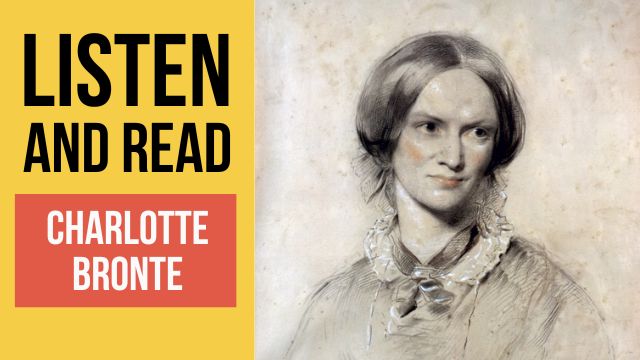
Задания к тексту
- Прочитайте текст про Шарлотту Бронте на английском.
- Выучите незнакомые слова или выражения.
- Чтобы лучше запомнить новую лексику, напишите по одному предложению с каждым выученным словом/выражением.
Это вариант текста с аудио. Ниже вы найдете такой же текст с переводом.
Скачать аудио.
Charlotte Bronte
Charlotte Bronte was a British novelist and poet who is best known for her novel «Jane Eyre.» Born in 1816, Bronte was the oldest of the Bronte sisters, a group of literary siblings that included Emily and Anne, who were also successful writers.
«Jane Eyre,» which was published in 1847, is a classic of English literature and is considered one of the first novels to feature a strong, independent female protagonist. The novel tells the story of Jane, an orphan who becomes a governess and falls in love with her employer, Mr. Rochester. The book explores themes of love, independence, and social class and has been widely adapted into plays, films, and television series.
In addition to «Jane Eyre,» Bronte also wrote several other novels, including «Shirley» and «Villette,» as well as poetry. She died in 1855 at the age of 38.
Текст на английском языке с переводом. Charlotte Bronte — Шарлотта Бронте
Это сочинение на тему «Charlotte Bronte» с переводом. Ниже вы найдете список полезных слов.
| Тест на английском | Перевод |
|---|---|
| Charlotte Bronte was a British novelist and poet who is best known for her novel «Jane Eyre.» | Шарлотта Бронте — британская писательница и поэтесса, наиболее известная своим романом «Джейн Эйр». |
| Born in 1816, Bronte was the oldest of the Bronte sisters, a group of literary siblings that included Emily and Anne, who were also successful writers. | Бронте родилась в 1816 году и была старшей из сестер Бронте — группы писательниц-сестер, в которую входили Эмили и Энн, также ставшие успешными писательницами. |
| «Jane Eyre,» which was published in 1847, is a classic of English literature and is considered one of the first novels to feature a strong, independent female protagonist. | Роман «Джейн Эйр», опубликованный в 1847 году, является классикой английской литературы и считается одним из первых романов с сильной, независимой женщиной-протагонистом. |
| The novel tells the story of Jane, an orphan who becomes a governess and falls in love with her employer, Mr. Rochester. | В романе рассказывается история Джейн, сироты, которая становится гувернанткой и влюбляется в своего работодателя, мистера Рочестера. |
| The book explores themes of love, independence, and social class and has been widely adapted into plays, films, and television series. | Книга раскрывает темы любви, независимости и социальных классов и была многократно адаптирована в пьесах, фильмах и телесериалах. |
| In addition to «Jane Eyre,» Bronte also wrote several other novels, including «Shirley» and «Villette,» as well as poetry. | Помимо «Джейн Эйр», Бронте написала еще несколько романов, в том числе «Ширли» и «Виллетт», а также стихи. |
| She died in 1855 at the age of 38. | Она умерла в 1855 году в возрасте 38 лет. |
Полезные слова:
- to be the oldest – быть самой старшей.
- siblings – браться и сестры, дети одних родителей.
- classic of literature – классика литературы.
- independent – независимый.
- protagonist – главный герой.
- orphan – сирота.
- governess – гувернантка.
- to fall in love with smb – влюбиться в кого-то.
- to explore a theme – исследовать, раскрывать тему.
- social class – социальный класс.
- to be adapted into – быть адаптированным в качестве чего-то.
- television series – телесериал.
- several – несколько.
- as well as smt – а также что-то.
Здравствуйте! Меня зовут Сергей Ним, я автор этого сайта, а также книг, курсов, видеоуроков по английскому языку.
Подпишитесь на мой Телеграм-канал, чтобы узнавать о новых видео, материалах по английскому языку.
У меня также есть канал на YouTube, где я регулярно публикую свои видео.
Charlotte Bronte
Charlotte Bronte was born in a small town in England in 1816. Charlotte and her sisters, Emily and Ann had a very hard life, from early childhood they knew poverty and very hard work. Charlotte received her education at an orphanage (which she de- scribed in her novel Jane Eyre). After that she worked as a governess and a teacher.
The works of Charlotte Bronte, together with Charles Dickens, William Thackeray and Elisabeth Gaskell are considered to belong to the fine school of English realism of the first half of the 19th century.
In her works she wrote about the society she lived in and criticized it. Her first novel The Professor was published only after Charlotte’s death.
The best novel Jane Eyre, published in 1847, is partly biographical. In 1849 the novel Shirley was published.
The story is about the Luddites, workers who did not understand that the real enemy of the working class were the capitalists and aristocrats. They thought that machinery, which they destroyed, was their enemy. The last novel Vilette came out in 1853.
Charlotte Bronte died from tuberculosis in 1855. The three Bronte sisters are well known writers and their books are published in many countries.
Шарлотта Бронте (перевод)
Шарлотта Бронте родилась в небольшом городе в Англии в 1816 г Жизнь Шарпотты и ее сестер Эмилии и Анны была очень трудной. С детства они познали бедность и очень тяжелый ТРУД.
Шарлотта получила образование в приюте для сирот (который она описала в романе Джен Эйр), После этого она работала гувернанткой и учительницей.
Считается, что произведения Шарлотты Бронте, наряду с произведениями Чарлза Диккенса, Уильяма Теккерея и Элизабет Гаскел, принадлежат к лучшим образцам школы английского реализма первой половины девятнадцатого столетия.
В своих работах она описывала жизнь общества, в котором она жила, и критиковала его. Ее первый роман Профессор был опубликован только после смерти Шарлотты.
Лучший ее роман Джен Эйр, опубликованный в 1847 году, отчасти автобиографичен. В 1848 году был опубликован роман Шерли. Это рассказ о луддитах — рабочих, которые не понимали, что действительными врагами рабочего класса были капиталисты и аристократы. Они считали своими врагами машины и разрушили их.
Последний роман Вилетт вышел в 1853 г. Шарлотта Бронте умерла от туберкулеза в 1855 г. Три сестры Бронте — известные писательницы, и их произведения публикуются во многих странах.


- Entertainment & Pop Culture
- Geography & Travel
- Health & Medicine
- Lifestyles & Social Issues
- Literature
- Philosophy & Religion
- Politics, Law & Government
- Science
- Sports & Recreation
- Technology
- Visual Arts
- World History
- On This Day in History
- Quizzes
- Podcasts
- Dictionary
- Biographies
- Summaries
- Top Questions
- Week In Review
- Infographics
- Demystified
- Lists
- #WTFact
- Companions
- Image Galleries
- Spotlight
- The Forum
- One Good Fact
- Entertainment & Pop Culture
- Geography & Travel
- Health & Medicine
- Lifestyles & Social Issues
- Literature
- Philosophy & Religion
- Politics, Law & Government
- Science
- Sports & Recreation
- Technology
- Visual Arts
- World History
- Britannica Classics
Check out these retro videos from Encyclopedia Britannica’s archives. - Demystified Videos
In Demystified, Britannica has all the answers to your burning questions. - #WTFact Videos
In #WTFact Britannica shares some of the most bizarre facts we can find. - This Time in History
In these videos, find out what happened this month (or any month!) in history. - Britannica Explains
In these videos, Britannica explains a variety of topics and answers frequently asked questions.
- Student Portal
Britannica is the ultimate student resource for key school subjects like history, government, literature, and more. - COVID-19 Portal
While this global health crisis continues to evolve, it can be useful to look to past pandemics to better understand how to respond today. - 100 Women
Britannica celebrates the centennial of the Nineteenth Amendment, highlighting suffragists and history-making politicians. - Britannica Beyond
We’ve created a new place where questions are at the center of learning. Go ahead. Ask. We won’t mind. - Saving Earth
Britannica Presents Earth’s To-Do List for the 21st Century. Learn about the major environmental problems facing our planet and what can be done about them! - SpaceNext50
Britannica presents SpaceNext50, From the race to the Moon to space stewardship, we explore a wide range of subjects that feed our curiosity about space!



